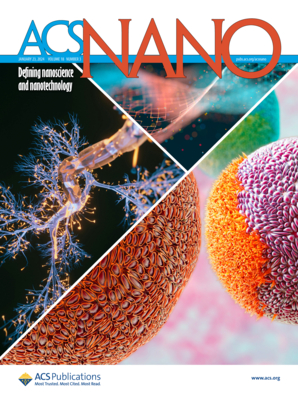Targeted Collagen Degradation by an MRI Probe Facilitates siRNA Delivery for Sequential Theranostics in Pulmonary Fibrosis
IF 15.8
1区 材料科学
Q1 CHEMISTRY, MULTIDISCIPLINARY
引用次数: 0
Abstract
Pulmonary fibrosis (PF) is characterized by dense collagen and mucus barriers that significantly limit drug delivery to the lungs. Clearing the collagen barrier can enhance drug delivery efficiency. Nevertheless, the heterogeneity of collagen states among patients poses a challenge. Therefore, real-time monitoring of the collagen clearance status is essential for PF personalized therapy. Herein, sequential theranostic platforms are proposed for collagen targeting and magnetic resonance imaging (MRI) monitoring to guide small interfering RNA (siRNA) delivery. First, for collagen barrier targeting-degrading, collagenase is conjugated with a collagen-targeting peptide capable of chelating the MRI contrast agent Gd(III), forming Col I T-D. This allows real-time, noninvasive MRI monitoring of the dynamic collagen clearance process. Second, guided by MRI, the zwitterionic polymer-based siRNA vectors (siTGF-β1@TZ) with mucus-penetrating and fibroblast-targeting capabilities are inhaled under an optimal state of collagen barrier. The sequential application of Col I T-D and siTGF-β1@TZ demonstrates significant lesion enrichment and therapeutic efficacy in PF treatment. Collectively, this study provides a novel perspective on dynamically monitoring collagen clearance status and guiding the sequential delivery of siRNA, offering a promising strategy for personalized PF therapy.

肺纤维化(PF)的特征是致密的胶原蛋白和粘液屏障,这大大限制了向肺部的药物输送。清除胶原屏障可以提高给药效率。然而,患者之间胶原蛋白状态的异质性带来了挑战。因此,实时监测胶原蛋白的清除状态对于PF个性化治疗至关重要。本文提出了胶原蛋白靶向和磁共振成像(MRI)监测的连续治疗平台,以指导小干扰 RNA(siRNA)的递送。首先,在胶原屏障靶向降解方面,胶原酶与能够螯合磁共振成像造影剂 Gd(III)的胶原靶向肽共轭,形成 Col I T-D。这样就可以通过磁共振成像对胶原蛋白的动态清除过程进行实时、无创的监测。其次,在核磁共振成像的引导下,在胶原屏障的最佳状态下吸入具有粘液穿透和成纤维细胞靶向能力的基于齐聚物的 siRNA 载体(siTGF-β1@TZ)。Col I T-D 和 siTGF-β1@TZ 的连续应用证明了在 PF 治疗中显著的病灶富集和疗效。总之,这项研究为动态监测胶原清除状态和指导 siRNA 顺序递送提供了一个新的视角,为个性化 PF 治疗提供了一种前景广阔的策略。
本文章由计算机程序翻译,如有差异,请以英文原文为准。
求助全文
约1分钟内获得全文
求助全文
来源期刊

ACS Nano
工程技术-材料科学:综合
CiteScore
26.00
自引率
4.10%
发文量
1627
审稿时长
1.7 months
期刊介绍:
ACS Nano, published monthly, serves as an international forum for comprehensive articles on nanoscience and nanotechnology research at the intersections of chemistry, biology, materials science, physics, and engineering. The journal fosters communication among scientists in these communities, facilitating collaboration, new research opportunities, and advancements through discoveries. ACS Nano covers synthesis, assembly, characterization, theory, and simulation of nanostructures, nanobiotechnology, nanofabrication, methods and tools for nanoscience and nanotechnology, and self- and directed-assembly. Alongside original research articles, it offers thorough reviews, perspectives on cutting-edge research, and discussions envisioning the future of nanoscience and nanotechnology.
 求助内容:
求助内容: 应助结果提醒方式:
应助结果提醒方式:


